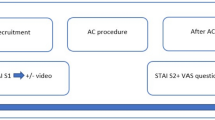Abstract
Introduction and hypothesis
Evidence regarding how women feel about episiotomies is not recorded in the literature. As the most common surgical procedure, there is a need to understand how women feel about episiotomy.
Methods
The primary outcome was to identify the percentage of women who would accept an episiotomy if required. A literature review was compiled to provide nulliparous women in their third trimester with evidence-based information about episiotomies and perineal tears. Questions eliciting demographics, pre-information level of anxiety and acceptance of episiotomy were asked. After reading the information sheets, anxiety and knowledge were assessed again. Changes in anxiety levels from pre- to post-information were investigated using paired samples t tests. Because anxiety was measured on a scale, we assessed potential departures from normality by using the Wilcoxon signed-rank test. Questions also assessed the value women placed on this form of education.
Results
There were 105 responses, with 88% accepting episiotomy, 2% declining and 10% seeking more information to decide. Eighty-one percent of women agreed that the information provided helped them to understand more about childbirth and 62% agreed that they felt more comfortable with the birthing process after reading the material. There was a reduction in anxiety levels regarding episiotomies after reading information (p = 0.002) and perineal tears (p = 0.02).
Conclusions
Most women will accept an episiotomy if required. Antenatal education about episiotomies is important to women and helps them feel more comfortable with the birthing process. Written information increases acceptance and reduces anxiety levels regarding episiotomies.

Similar content being viewed by others
References
Clesse C, Lighezzolo-Alnot J, De Lavergne S, Hamlin S, Scheffler M. Statistical trends of episiotomy around the world: comparative systematic review of changing practices. Health Care Women Int. 2018;39(6):644–62.
Jiang H, Qian X, Carroli G, Garner P. Selective versus routine use of episiotomy for vaginal birth. Cochrane Database Syst Rev. 2017;2:CD000081.
Royal College of Obstetricians and Gynaecologists (2015) The management of third-and fourth-degree perineal tears. The Royal College of Obstetricians and Gynaecologists; 2015 [https://www.rcog.org.uk/globalassets/documents/guidelines/gtg-29.pdf], Accessed 15 April 2018.
Women's Health Committee (2016) Instrumental vaginal birth. The Royal Australian and New Zealand College of Obstetricians and Gynaecologists. https://www.ranzcog.edu.au/RANZCOG_SITE/media/RANZCOG-MEDIA/Women%27s%20Health/Statement%20and%20guidelines/Clinical-Obstetrics/Instrumental-Vaginal-Birth-(C-Obs-16)-Review-March-2016.pdf?ext=.pdf, Accessed 15 April 2018.
De Leeuw J, de Wit C, Kuijken JP, Bruinse HW. Mediolateral episiotomy reduces the risk for anal sphincter injury during operative vaginal delivery. BJOG. 2008;115(1):104–8.
Van Bavel J, Hukkelhoven CWPM, de Vries C, Papatsonis DNM, de Vogel J, Roovers JWR, et al. The effectiveness of mediolateral episiotomy in preventing obstetric anal sphincter injuries during operative vaginal delivery: a ten-year analysis of a national registry. Int Urogynecol J. 2018;29(3):407–13.
Gurol-Urganci I, Cromwell DA, Edozien LC, Mahmood TA, Adams EJ, Richmond DH, et al. Third- and fourth-degree perineal tears among primiparous women in England between 2000 and 2012: time trends and risk factors. BJOG. 2013;120(12):1516–25.
NMPA Project Team (2018) National Maternity and perinatal audit: clinical report 2017- revised edition. RCOG London, http://www.maternityaudit.org.uk/downloads/NMPA%20Clinical%20Report%202018.pdf, Accessed 5 May 2018.
Australian Institute of Health and Welfare (2016) National core maternity indicators—stage 3 and 4: results from 2010–2013. AIHW Canberra, http://www.aihw.gov.au/publication-detail/?id=60129555634. Accessed 5 May 2018.
Royal College of Obstetricians and Gynaecologists (2018) OASI care bundle project: background. RCOG London, https://www.rcog.org.uk/en/guidelines-research-services/audit-quality-improvement/oasi-care-bundle/oasi-background/. Accessed 3 July 2018.
Women's Health Australasia. (2018) WHA National collaborative. Women’s Hospitals Australasia, https://women.wcha.asn.au/wha-national-collaborative. Accessed 15 March 2018.
Lowe NK. Self-efficacy for labor and childbirth fears in nulliparous pregnant women. J Psychosom Obstet Gynaecol. 2000;21(4):219–24.
Rondung E, Thomtén J, Sundin Ö. Psychological perspectives on fear of childbirth. J Anxiety Disord. 2016;44:80–91.
Areskog B, Kjessler B, Uddenberg N. Identification of women with significant fear of childbirth during late pregnancy. Gynecol Obstet Investig. 1982;13(2):98–107.
Redevelopment Project Office. About us, 2019. http://www.stgeorgehospitalredev.health.nsw.gov.au/about-us. Accessed 3 March 2019.
South Eastern Sydney Local Health District (2019) Delivery Suite. https://www.seslhd.health.nsw.gov.au/st-george-hospital/services-clinics/directory/womens-and-childrens-health/delivery-suite. Accessed 3 March 2019.
Räisänen S, Selander T, Cartwright R, Gissler M, Kramer MR, Laine K, et al. The Association of Episiotomy with obstetric anal sphincter injury–a population based matched cohort study. PLoS One. 2014;9(9):e107053.
Kalis V, Landsmanova J, Bednarova B, Karbanova J, Laine K, Rokyta Z. Evaluation of the incision angle of mediolateral episiotomy at 60 degrees. Int J Gynaecol Obstet. 2011;112:220–4.
Rubak S, Sandbaek A, Lauritzen T, Christensen B. Motivational interviewing: a systematic review and meta-analysis. Br J Gen Pract. 2005;55(513):305–12.
Patel D, Nasir S, Elati A, Vernon G, Weeks A. Historical trends in the timing of informed consent for research into intrapartum complications. BJOG. 2012;119(3):361–5.
Hibbard J, Greene J. What the evidence shows about patient activation: better health outcomes and care experiences; fewer data on costs. Health Aff (Millwood) 2013;32(2):207–14
Morris E. Obtaining valid consent. RCOG London. 2015 https://www.rcog.org.uk/globalassets/documents/guidelines/clinical-governance-advice/cga6.pdf Accessed 2 September 2018.
Acknowledgements
Liz Ross provided extensive feedback and helped to edit the information package.
Imelda Manners provided midwifery feedback for developing the information package and logistical help for recruitment.
Author information
Authors and Affiliations
Corresponding author
Ethics declarations
Conflicts of interest
The authors report no conflicts of interest.
Although no direct funding was received for the project, Dr. Faasse is supported by an Australian Research Council Discovery Early Career Research Fellowship (DE180100471).
Additional information
Publisher’s note
Springer Nature remains neutral with regard to jurisdictional claims in published maps and institutional affiliations.
Rights and permissions
About this article
Cite this article
Alexander, J.W., Karantanis, E., Turner, R.M. et al. Patient attitude and acceptance towards episiotomy during pregnancy before and after information provision: a questionnaire. Int Urogynecol J 31, 521–528 (2020). https://doi.org/10.1007/s00192-019-04003-x
Received:
Accepted:
Published:
Issue Date:
DOI: https://doi.org/10.1007/s00192-019-04003-x




